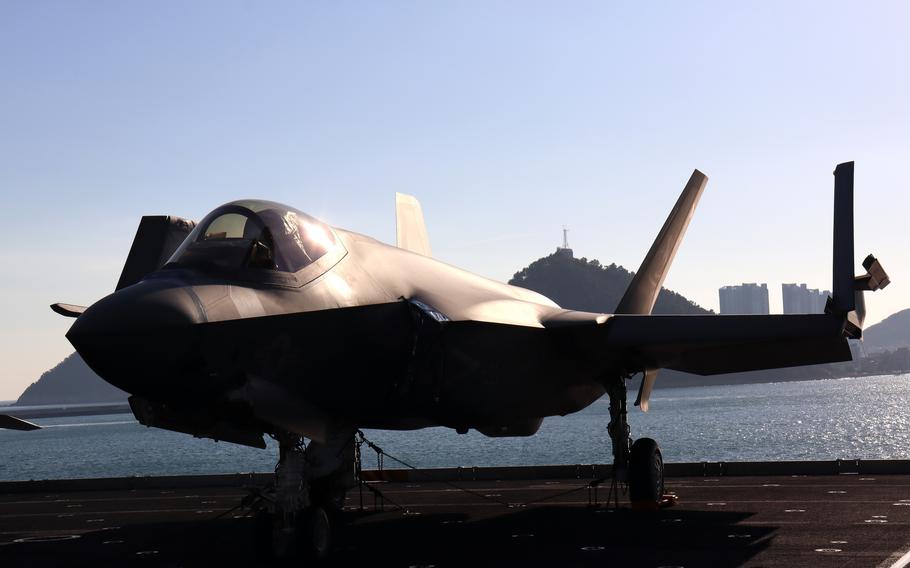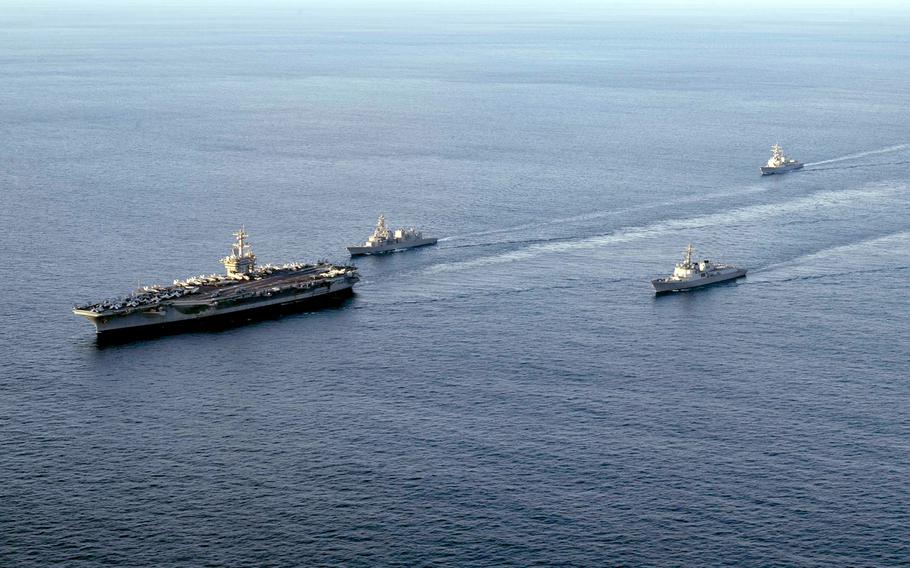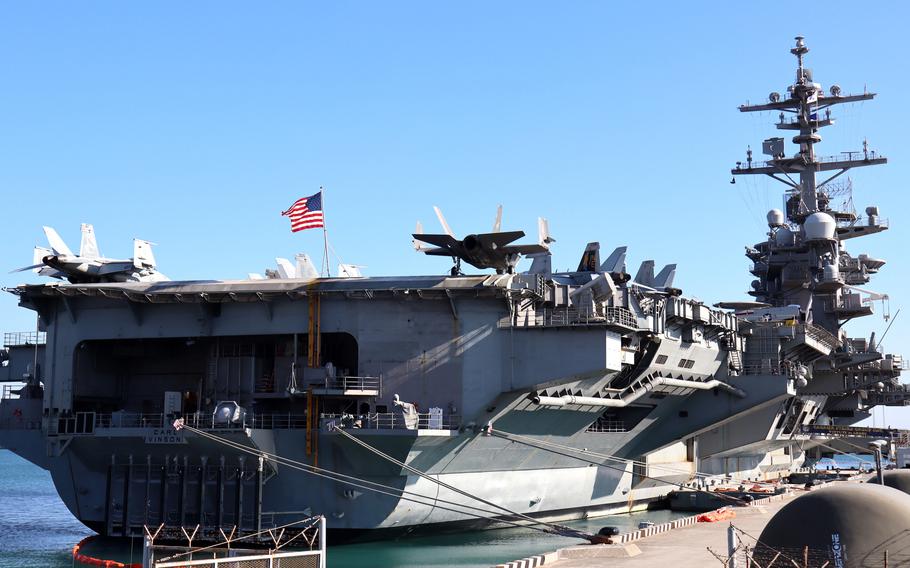
An F-35C Lightning II stealth fighter rests on the flight deck of the aircraft carrier USS Carl Vinson in Busan, South Korea, Nov. 22, 2023. (David Choi/Stars and Stripes)
SUWON, South Korea — Warships from the United States, South Korea and Japan trained near the Korean Peninsula over the weekend to better prepare for North Korean provocations, according to the South’s military.
The one-day exercise came four days after Pyongyang scrapped the Comprehensive Military Agreement, which has eased tensions at the border since 2018.
The aircraft carrier USS Carl Vinson, guided-missile destroyer USS Sterett and destroyer USS Kidd trained southeast of Jeju Island alongside the South Korean and Japanese destroyers Sejong the Great and JS Kirisame, the Ministry of National Defense said in a news release Sunday.
With North Korean unmanned aerial vehicles in mind, the ships carried out air-defense drills and maritime maneuvers, the ministry said.
The exercise was “an opportunity to strengthen the response capabilities and posture of South Korea, the U.S. and Japan at a time when North Korea’s nuclear and missile threats are escalating,” South Korean navy Capt. Kim Sung-pil said in the release.
The Carl Vinson arrived at Busan, South Korea’s largest port, on Nov. 21. The warship is the third aircraft carrier to dock in South Korea this year after the USS Nimitz in March and USS Ronald Reagan in October.

The USS Carl Vinson sets sail for a trilateral exercise south ofJeju Island, South Korea, Sunday, Nov. 26, 2023. The aircraft carrier is followed by the JS Kirisame, left, ROKS Sejong the Great, center and the USS Kidd. (U.S. Navy)
President Joe Biden and South Korean President Yoon Suk Yeol agreed to boost the visibility of U.S. strategic assets on the peninsula to “manage the threat to the nonproliferation regime posed by [North Korea],” according to a joint statement from the leaders on April 26.
Since then, U.S. military assets have made appearances in South Korea on a level not seen in decades.
The USS Kentucky sailed to Busan in July, becoming the first nuclear-capable U.S. submarine to visit the country in 42 years. A nuclear-capable B-52 Stratofortress visited in October, becoming the first bomber of its type to touch down in the country in at least 30 years.
Also in October, the Ronald Reagan Carrier Strike Group conducted the Navy’s first maritime exercise with South Korea and Japan or the first time since 2016.
Defense Secretary Lloyd Austin, South Korean Defense Minister Shin Won-sik and Japanese Defense Minister Kihara Minoru held a virtual meeting Nov. 12 and announced that a “multi-year trilateral exercise plan” between the three militaries was nearly complete.
The defense chiefs also confirmed that a real time missile-warning system for the three nations is nearly complete and will be operational in December.

The aircraft carrier USS Carl Vinson aircraft carrier docks in Busan, South Korea, Wednesday, Nov. 22, 2023 (David Choi/Stars and Stripes)
The Comprehensive Military Agreement, signed in 2018 by then-South Korean President Moon Jae-in and North Korean leader Kim Jong Un, enacted a host of deconfliction measures at the border, including a ban on armed guards at guard posts and establishing no-fly zones.
Seoul’s revision of the accord last week lifted the prohibition on aircraft flying near the border. North Korea was “entirely responsible” for Seoul’s decision, which was prompted by Pyongyang’s successful launch of a military spy satellite on Nov. 21, Ministry of National Defense spokesman Heo Tae-keun told reporters Wednesday.
Pyongyang responded by scrapping the agreement entirely.
North Korea will “deploy more powerful armed forces and new-type military hardware in the region” near the border, according to a Thursday statement by the state-run Korean Central News Agency.
North Korean soldiers have returned to at least one abandoned guard post with “heavy weaponry,” according to a Monday news release from the South’s military.
Stars and Stripes reporter Hana Kusumoto contributed to this report.